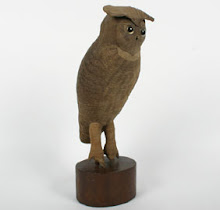museum in Maryland not only tells their story but strives to keep the tradition alive.
Anybody can make one," says Bill Payne, turning a bit of tupelo pine in his hands. The 69-year-old retiree worries a short-bladed knife across its surface. By the end of the day, with patience and careful craft, he will have given the wood the shapely curves of the head of a pintail drake. The body of the duck may take a week's time to carve and sand smooth. Payne will then burn in feather marks and coat the decoy with enamel, somehow capturing the look and feel of a real creature, the subtle blue-greens and browns of a living bird. He'll sell his work for $300.
"Oh, I don't do it for the money," he adds quickly. "For me, decoy making is so relaxing, I'd give 'em away if I could."
That would cause something of a stir here in Havre de Grace, Md., where Payne is showing 30 or so of his decoys at the 11th annual Duck Fair. His fellow craftsmen are offering decoys for as little as $40 -- and as much as $1,000. But the true connoisseur will want a duck carved by one of the brothers Steven and Lemual Ward, if they have $95,000 for a 1932 original.
The Duck Fair is held on the grounds of the Havre de Grace Decoy Museum, located at the water's edge where the Susquehanna River meets the Chesapeake Bay. Opened in 1986, the museum is one of the largest of its kind in the world and houses one of the finest collections of antique decoys in the United States. Visitors can admire hunting decoys from President Grover Cleveland's gunning days. There are samples, too, from the work of all the great Chesapeake Bay decoy makers, including Havre de Grace's R. Madison Mitchell, who founded the museum. (His old wood shop is still out back, operated by the museum as a teaching tool.) Both Ward brothers are represented. Though they died years ago, life-size mannequins -- a kind of "human decoy" -- depict them with tools in hand, carving wooden waterfowls behind a glass-enclosed exhibit space.
In 1857, Havre de Grace decoy makers typically sold 100 decoys for a total of $25. Today, just one of the decoys from that time might fetch $50,000 at a high-end auction, where the suspenders-and-cigar crowd snaps up antiques as if they were Picassos.
Duck decoys have been around as long as people have hunted the birds they resemble. Set out on water or in fields, they are meant to lure their "fellows" from the air with the illusion of safe haven or good feeding. In fact, they invite the fliers into hunters' snares.
Ancient Egypt's King Tut had a beautifully carved and painted wooden duck placed in his tomb, perhaps a decoy for hunting in the afterlife. When the colonists came to North America, they found natives hunting with their own versions of decoys, usually sticks and bark disguised with feathers and painted with berry juices. The European settlers built on this tradition with carved wooden decoys colored with oil paints, an art form found nowhere else on earth.
The museum is all about "keeping the craft alive," says spokeswoman Susan Garbacik. Collectors of expensive antiques and manufacturers of knockoff plastic replicas are all welcome. Squadrons of visiting artists demonstrate their craft and do some selling.
Take Jim Pierce, for example. Sought out by hunters and collectors alike, Pierce carves beautifully austere but eye-catching canvasback ducks and Canada geese. During the Duck Fair, enthusiasts can admire the work of many such craftsmen, moving from table to table laden with wigeons, common goldeneyes, ruddy and wood ducks, Atlantic brants and coots, blackhead and redhead ducks, red- and blue-winged teals, mallards, shovelers, tundra swans, mergansers, surf scoters and lesser scaups.
Of course, the youngsters are much in evidence among the wooden quackers. "Whoo-dell, wack-yak-wack-wack," they call as they flit by with their newly made duck calls. They skirt under Payne's arms and tumble down the path for a seat at the head-carving tent.
Their day has been filled with high adventure at the fair, with duck- and goose-calling competitions, decoy painting, retriever demonstrations and now head carving. "Open-head competition" means anyone can enter the timed race to carve a face onto a block of pine, with the best likeness winning a prize.
"They're all so pretty," Payne says. "It's what makes decoy carving so satisfying. When you're done, there's this beautiful thing to leave behind, or give to a friend, or, well, sell."
He is doing more than his share to preserve the tradition. He and his wife, Ann, have plowed part of their retirement resources into establishing the Atlantic Wildfowl Heritage Museum in their historic home in Virginia Beach. What once was a part-time hobby now occupies "most of our time," says Ann Payne.
"Decoys are found all the way back to Early American times," her husband muses in response. "It's up to us to pass on the old-time know-how to the next generation."
By: Raymond M. Lane
skip to main |
skip to sidebar



Wood Decoy for Bidding

What You need for your home?
Duck Wood Decoy

Wood Decoy on Image

